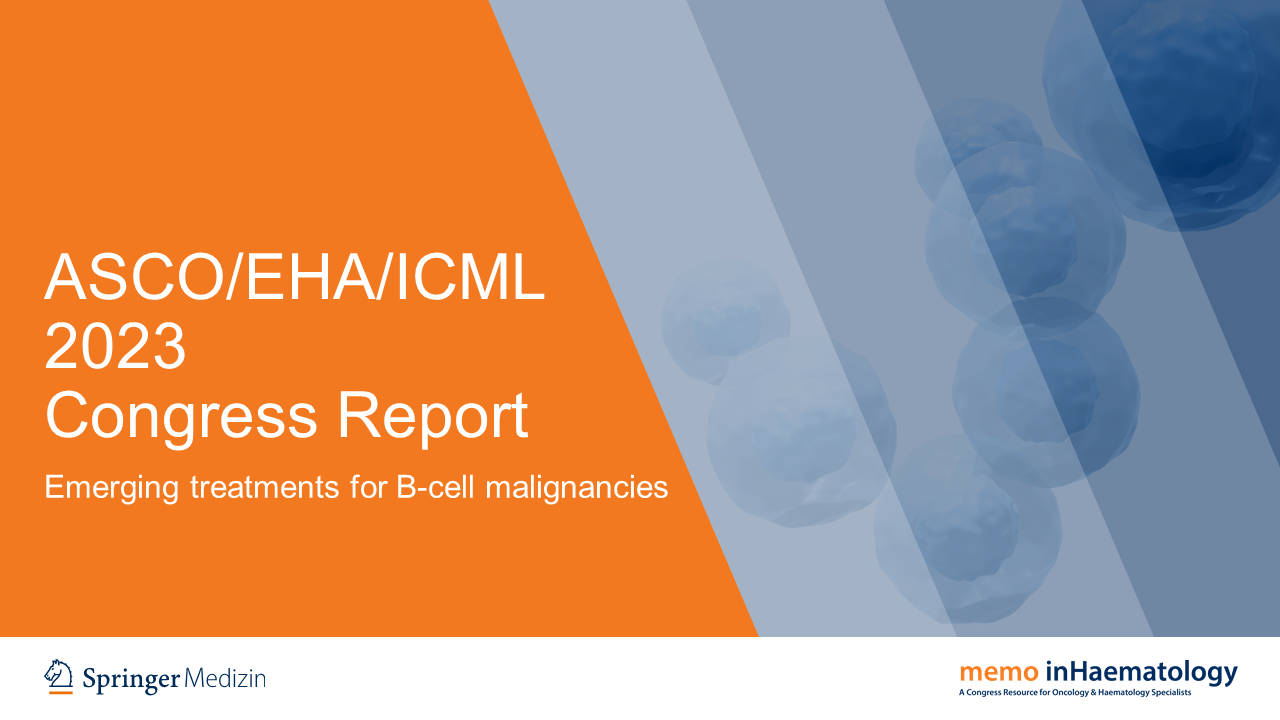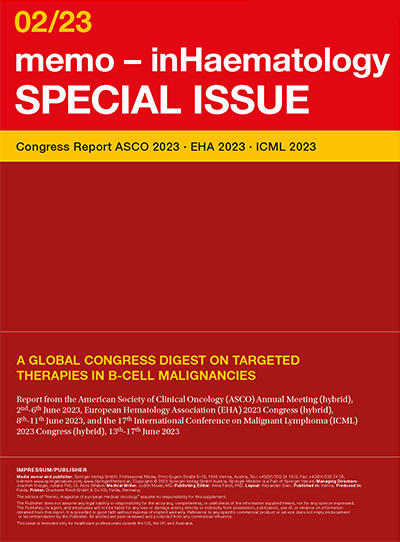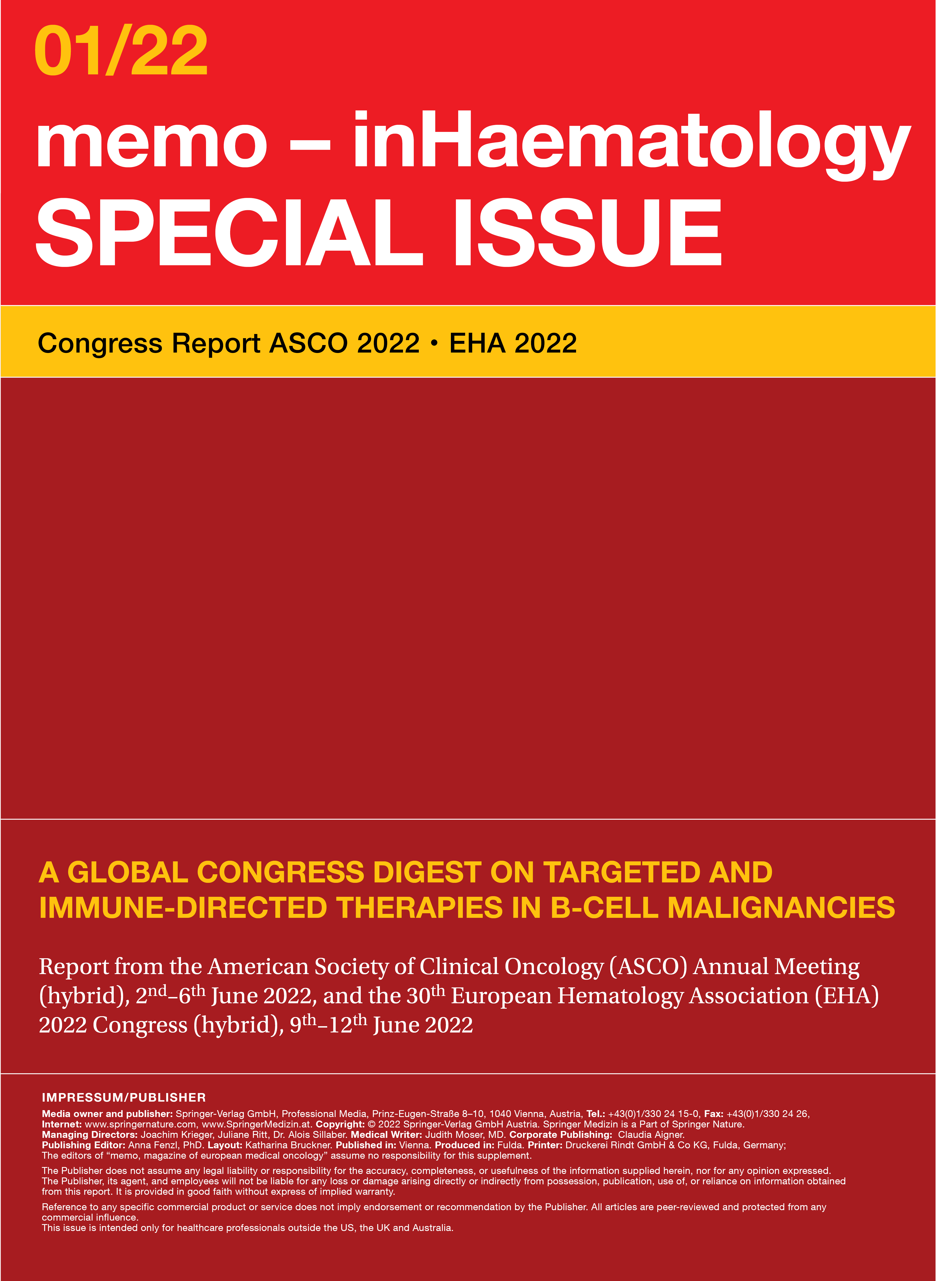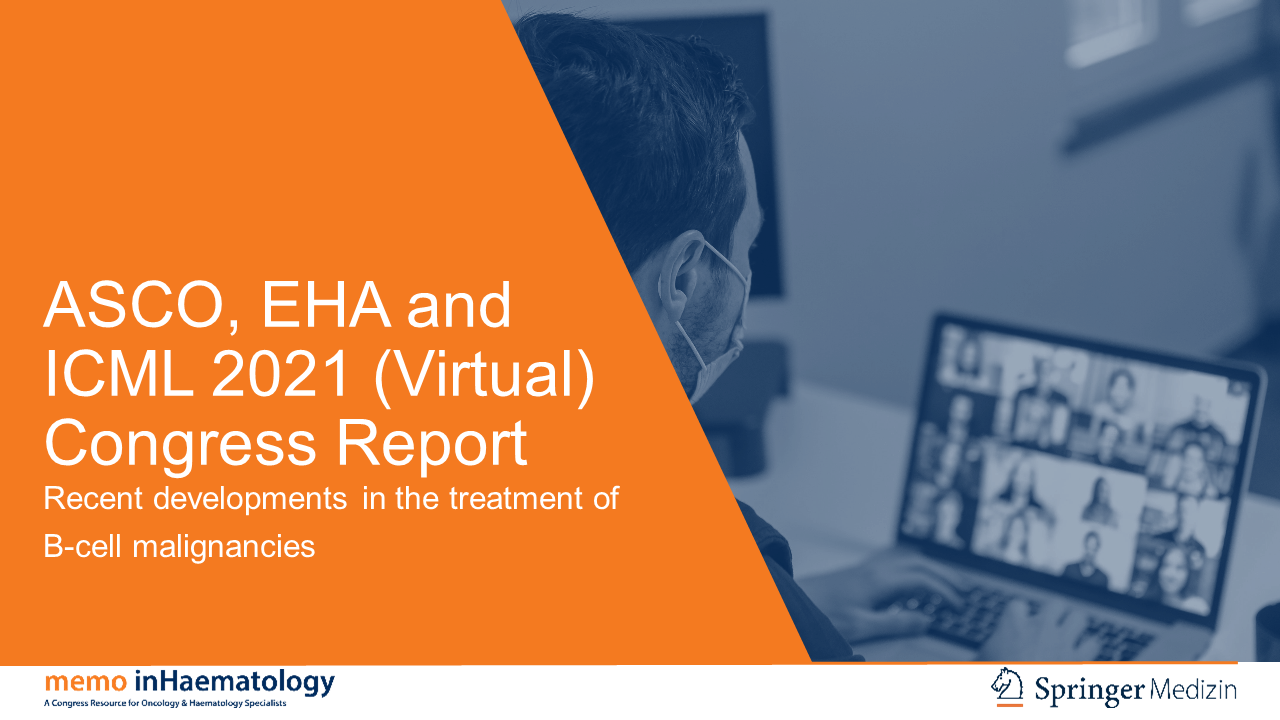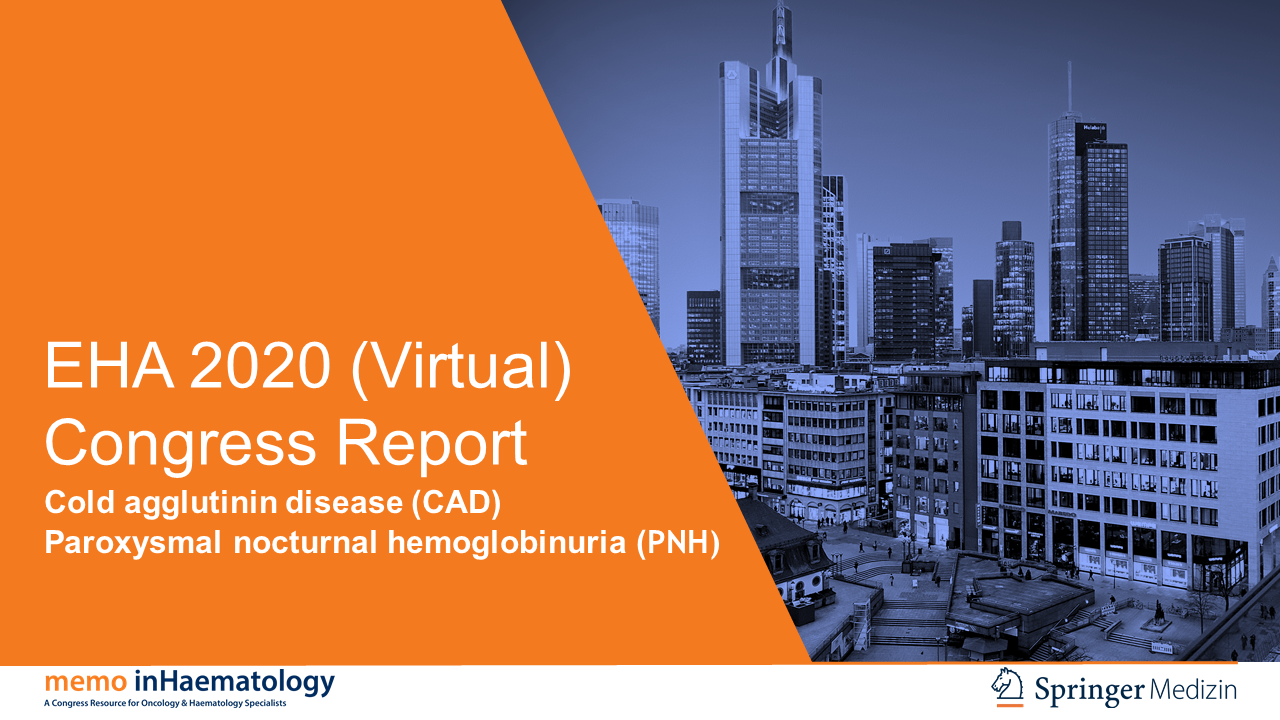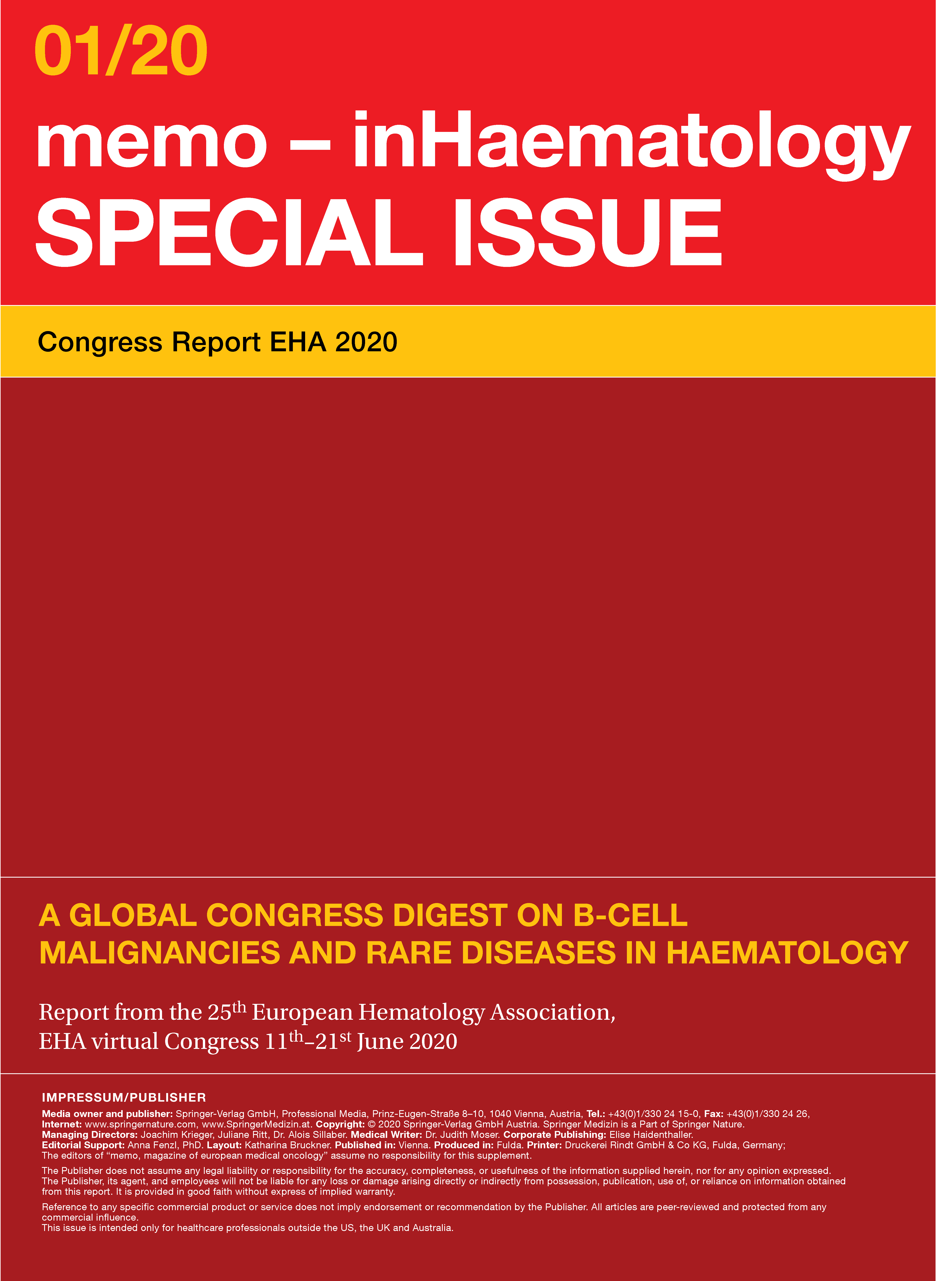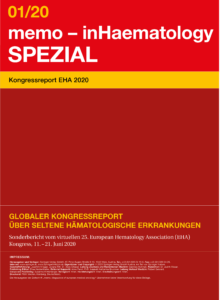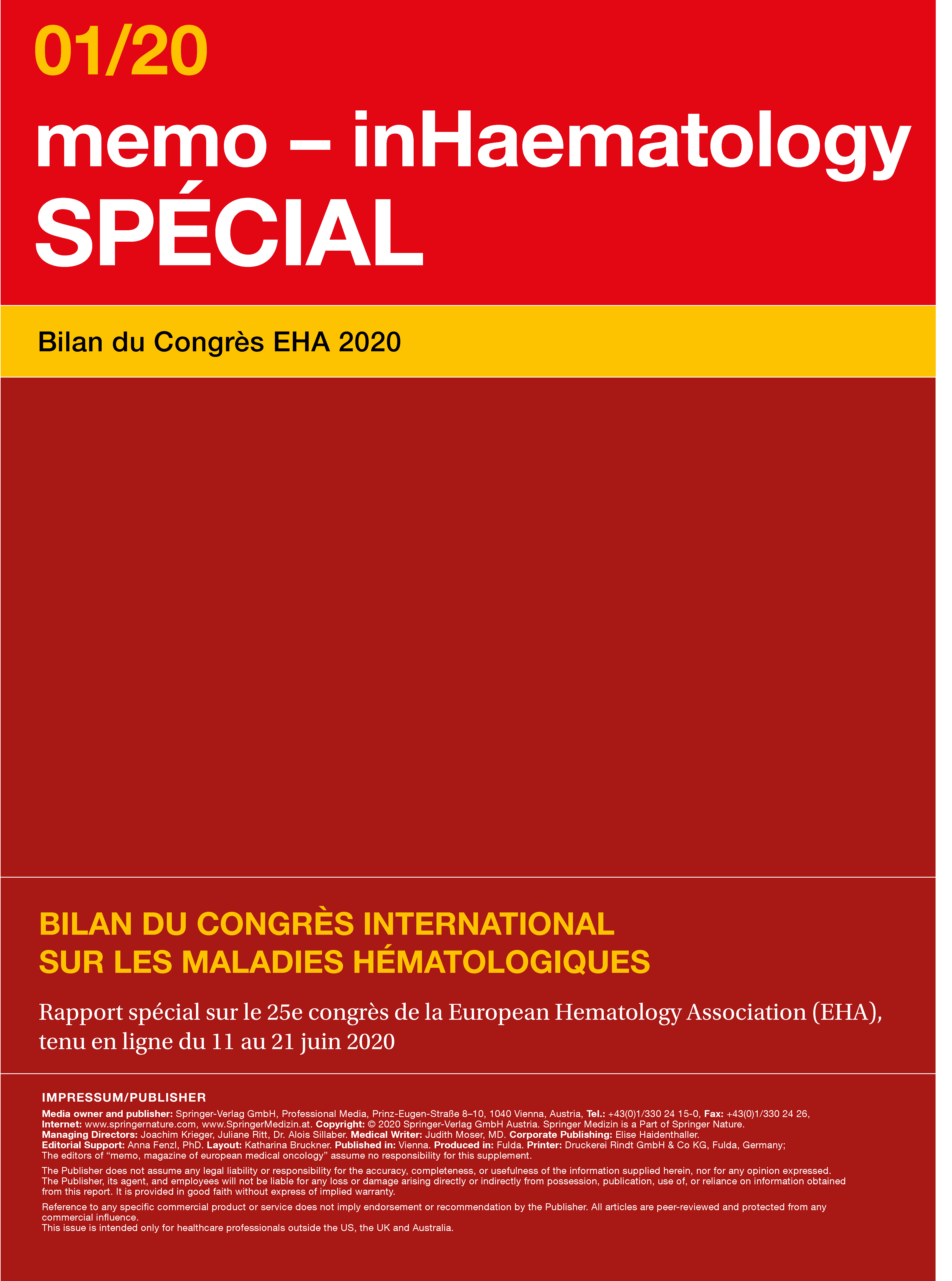ASCO/EHA/ICML 2023
Lecture Board: Othman Al-Sawaf, MD; Arnon P. Kater, MD, PhD; Reid W. Merryman, MD; Silvana Novelli MD, PhD; Constantine Tam, MD; Catherine Thieblemont, MD, PhD; Jan Walewski MD, PhD; Emanuele Zucca, MD
Medical Writer: Judith Moser, MD
Publishing Editor: Anna Fenzl, PhD
Preface – ASCO/EHA/ICML 2023
Preface – ASCO/EHA/ICML 2023 © Dirk Gillissen – Arnon P. Kater, MD, PhD, Department of Hematology, Cancer Center Amsterdam, Amsterdam University Medical Center, University of Amsterdam, Amsterdam, Netherlands Dear Colleagues, Cutting-edge updates in the diagnosis and treatment of hematological malignancies were discussed by world-leading experts at the Annual Meeting of the American Society of Clinical Oncology (ASCO) in Chicago, USA, 2nd–6th June 2023, the European Hematology Association
Current insights into BTK inhibition and other targeted approaches in CLL
Current insights into BTK inhibition and other targeted approaches in CLL Treatment-naïve disease Ibrutinib vs. watch & wait in asymptomatic patients In the setting of early-stage, asymptomatic chronic lymphocytic leukemia (CLL), the concept of watch & wait in the era of targeted agents was challenged by the placebo-controlled, double-blind, phase III CLL12 study. This trial assessed the use of ibrutinib 420 mg OD (n = 182) vs. placebo (n = 181) until symptomatic disease progression
Follicular lymphoma: study results with bispecific antibodies and BTK inhibitors
Follicular lymphoma: study results with bispecific antibodies and BTK inhibitors Mosunetuzumab: CR at EOT Follicular lymphoma (FL) is the most common indolent non-Hodgkin lymphoma (NHL) subtype [1]. In general, it remains incurable with standard therapies, and most patients experience multiple relapses over time. Therefore, there remains a great need for innovative new regimens such as the first-in-class CD20xCD3 T-cell–engaging bispecific antibody mosunetuzumab that is being tested in a piv
Outcome improvements in relapsed and untreated marginal zone lymphoma
Outcome improvements in relapsed and untreated marginal zone lymphoma Final analysis of MAGNOLIA Systemic treatment for patients with advanced marginal zone lymphoma (MZL) is often based on regimens used in follicular lymphoma, although new agents and combinations are called for. As MZL depends on B-cell receptor signaling, treatment with BTK inhibitors is being investigated in clinical trials. The multicenter, open-label, single-arm, phase II MAGNOLIA study was initiated to assess the pote
Waldenström macroglobulinemia: findings from ASPEN and BRUIN
Waldenström macroglobulinemia: findings from ASPEN and BRUIN ASPEN: HRQoL for zanubrutinib vs. ibrutinib In the management of patients with Waldenström macroglobulinemia (WM), BTK inhibitors have changed the therapeutic landscape and are considered preferred treatment options for the first and later lines [1]. Compared to the first-in-class agent ibrutinib, the potent and irreversible BTK inhibitor zanubrutinib offers improved BTK selectivity that minimizes off-target effects and toxicities
DLBCL: treatment of elderly patients and relapsed disease
DLBCL: treatment of elderly patients and relapsed disease POLAR BEAR: novel regimen from the age of 75 Overall survival has improved considerably in the setting of diffuse large B-cell lymphoma (DLBCL). However, patients above the age of 80 years are an exception in terms of survival prolongation and therefore face an unmet clinical need [1]. At the same time, this is a group that constitutes an increasing proportion of DLBCL patients. The current treatment standard in elderly patients with
Updates on BTK- and Bcl-2–targeted treatment in various B-cell malignancies
Updates on BTK- and Bcl-2–targeted treatment in various B-cell malignancies Ibrutinib plus CIT: SELENE trial Survival outcomes typically deteriorate with repeated lines of chemoimmunotherapy (CIT) in patients with relapsed/refractory non-Hodgkin lymphoma. The randomized, double-blind phase III SELENE trial was conducted to determine whether the addition of the BTK inhibitor ibrutinib to CIT in patients with relapsed/refractory follicular lymphoma (FL) or marginal zone lymphoma (MZL) improves
EXPERT VIDEOS
All video interviews from ASCO/EHA/ICML 2023
Alessandra Tedeschi gives insights into the health-related quality of life data from the ASPEN study conducted in patients with Waldenström macroglobulinemia, discusses the notable results from the extended follow-up of the SEQUOIA study in patients with treatment-naïve chronic lymphocytic leukemia as well as the clinical activity of zanubrutinib in the setting of R/R marginal zone lymphoma while finally depicting her personal highlights from this year’s EHA congress.
Anna Schuh talks about genetic aberrations in subclones in terms of the molecular dynamics of relapse in patients with CLL, the benefits of liquid biopsies as well as the current role and future application of whole-genome sequencing in precision hematology while ultimately depicting her personal highlights from this year’s EHA congress.
Paolo Strati overviews how patient outcomes can be optimized with current therapies in relapsed or refractory diffuse large B-cell lymphoma in later lines and outlines which innovative approaches might become available in the long run for the treatment of R/R DLBCL. Finally, he explains what can be achieved today in patients with follicular lymphoma and high tumor burden and depicts his personal highlights from this year’s EHA congress.
Philipp Staber explains the role of functional drug testing in the treatment of patients with hematologic diseases, shares the rationale of the EXALT-2 trial as well as his thoughts on future developments in the field of precision medicine. Finally, he gives insights in the current research topics of the EHA SWG-Precision Hematology and their goal for the next five years.
ASCO/EHA 2022
Lecture Board: Othman Al-Sawaf, MD; Chan Cheah, MBBS, DMSc.; Naval Daver, MD; Shirley D’Sa, MD; Harry P. Erba, MD, PhD.; Wojciech Jurczak, MD, PhD.; Michael Wang, MD; Moshe Yair Levy, MD
Medical Writer: Judith Moser, MD
Publishing Editor: Anna Fenzl, PhD
Preface – EHA 2022
Preface – EHA 2022 Matthew S. Davids, MD, MMSc – Department of Medical Oncology, Dana-Farber Cancer Institute, Harvard Medical School, Boston, MA, USA Dear Colleagues, After 2 years of the COVID-19 pandemic, the Annual Meeting of the American Society of Clinical Oncology, held in Chicago, USA, and virtually from 3rd–7th June 2022, featured nearly 250 oral as well as over 2,200 poster presentations.
Updates and ancillary analyses in the setting of chronic lymphocytic leukemia
Updates and ancillary analyses in the setting of chronic lymphocytic leukemia Progression-free survival in GAIA/CLL13 In fit patients with advanced CLL of favorable genetic risk, chemoimmunotherapy (CIT) consisting of fludarabine/cyclophosphamide/rituximab (FCR) or bendamustine/rituximab (BR) still represents the treatment standard.
Marginal zone lymphoma: benefits of BTK inhibition in later lines
Marginal zone lymphoma: benefits of BTK inhibition in later lines Zanubrutinib in patients ≥ 65 years Patients with marginal zone lymphoma (MZL) usually show an indolent course of disease, although MZL remains largely incurable, particularly in the relapsed/refractory setting [1, 2].
Early-phase trials investigating novel agents in miscellaneous B-cell malignancies
Early-phase trials investigating novel agents in miscellaneous B-cell malignancies Large B-cell lymphoma: subcutaneous epcoritamab The prognosis is still poor for most patients with relapsed or refractory large B-cell lymphoma (LBCL) irrespective of therapeutic advances that have recently been achieved.
BTK inhibition in Waldenström’s macroglobulinemia: trial updates and real-world insights
BTK inhibition in Waldenström’s macroglobulinemia: trial updates and real-world insights The open-label, multicenter, randomized phase III ASPEN trial was set up to assess the efficacy and safety of the potent, selective, irreversible next-generation BTK inhibitor zanubrutinib in Waldenström’s macroglobulinemia (WM).
Prolonging remission in relapsed and refractory follicular lymphoma
Prolonging remission in relapsed and refractory follicular lymphoma Follicular lymphoma (FL) is a common indolent form of non-Hodgkin lymphoma that accounts for 20-25 % of all new NHL cases in Western countries [1].
New options in untreated and pretreated mantle cell lymphoma
New options in untreated and pretreated mantle cell lymphoma SHINE trial: first-line regimen for older patients Patients of an advanced age with previously untreated mantle cell lymphoma (MCL) usually receive chemoimmunotherapy regimens such as bendamustine/rituximab (BR), R-CHOP or bortezomib/rituximab/cyclophosphamide/doxorubicin/prednisone (VR-CAP), with BR having become the most commonly used first-line strategy [1].
Tackling acute myeloid leukemia via diverse pathways
Tackling acute myeloid leukemia via diverse pathways Mutations of FLT3 are found in approximately 30 % of patients with newly diagnosed acute myeloid leukemia (AML), with the internal tandem duplication (ITD) representing the most common type [1-4].
EXPERT VIDEOS
All video interviews from ASCO/EHA 2022
Naval Daver overviews the most promising new agents in the treatment of AML, how existing drugs can blend into new regimens and how the prognosis of patients with AML will evolve in the years to come. Finally, he talks about risk factors for ICI-related pneumonitis development and if pneumonitis increases mortality in AML patients.
Jorge Castillo explains the most meaningful diagnostic criteria for WM, give insights into the “real-world” treatment of WM with zanubrutinib, bortezomib and other treatment strategies and how to sequence therapies in WM. He explains promising modes of action of new agents in the treatment of WM and depicts his personal highlights from this year’s EHA congress.
Wojciech Jurczak outlines what can be achieved with the current standard treatments in the setting of follicular lymphoma, which findings have been observed for PI3K inhibitor therapy in the TIDAL study and were we are today with respect to CAR-T cell therapy for patients with follicular lymphoma.
Constantine Tam highlights the most relevant findings presented at EHA 2022 as well as promising modes of action of new agents in the treatment of indolent lymphomas. He explains how resistance to BTK inhibitors can be addressed in B-cell malignancies while giving an outlook on a BTK protein degrader and finally summarizes the long-term results obtained with zanubrutinib compared to ibrutinib in the ASPEN trial in patients with WM.
Shirley D’Sa discusses how the treatment and especially the prognosis of patients with WM evolved over the last decades, which approaches can be used to successfully treat patients with MYD88WTWM, how the interaction between WM cells and the bone marrow microenvironment can be used to develop new ways to overcome treatment resistance and finally explains how often the Binge-Neel Syndrome happens, how its diagnosed and how it should be treated.
ASCO/EHA/ICML 2021
Lecture Board: Othman Al-Sawaf, MD; Stephen M. Ansell, MD; PhD Jorge Castillo, MD; Chan Cheah, MBBS; Jeff Sharman, MD
Medical Writer: Judith Moser, MD
Publishing Editor: Anna Fenzl, PhD
Preface – ASCO/EHA/ICML 2021
Preface – ASCO/EHA/ICML 2021 Véronique Leblond, MD Department of Hematology, Pitié Salpêtrière Hospital Paris, France Dear Colleagues, As virtual scientific conferences are becoming part of our daily routine as clinicians and researchers, information in individual areas of interest is easily accessible across different congresses.
CLL/SLL: current perspectives across a range of potent agents
CLL/SLL: current perspectives across a range of potent agents ALPINE: zanubrutinib vs. ibrutinib The introduction of effective inhibitors of B-cell receptor signaling such as the BTK inhibitor ibrutinib has transformed the treatment of patients with chronic lymphocytic leukemia (CLL) and small lymphocytic lymphoma (SLL).
Waldenström’s macroglobulinemia: outcome optimization via combinations
Waldenström’s macroglobulinemia: outcome optimization via combinations Final analysis of iNNOVATE Ibrutinib is the only once-daily BTK inhibitor approved as a single agent or in combination with rituximab for patients with Waldenström’s macroglobulinemia (WM) across all lines of therapy.
Successful inhibition of PI3K, BTK, BCL2 and other targets in various B-cell malignancies
Successful inhibition of PI3K, BTK, BCL2 and other targets in various B-cell malignancies CHRONOS-3: copanlisib plus rituximab Rituximab monotherapy is a recognized standard of care in patients with relapsed indolent non-Hodgkin lymphoma (iNHL) who have had long remissions after rituximab-based therapy or who are unwilling or unfit to be treated with chemotherapy.
Extending anti-PD-1–based options in the setting of Hodgkin lymphoma
Extending anti-PD-1–based options in the setting of Hodgkin lymphoma Patients with relapsed or refractory classical Hodgkin lymphoma (cHL) who have failed high-dose chemotherapy and autologous stem cell transplantation (HDT/ASCT) have poor prognosis, which also applies to those with chemotherapy-resistant disease who are ineligible for HDT/ASCT [1-4].
Mantle cell lymphoma: improving outcomes in difficult-to-treat patient populations
Mantle cell lymphoma: improving outcomes in difficult-to-treat patient populations Updated results from MAGNIFY Mantle cell lymphoma (MCL) accounts for approximately 3–10 % of non-Hodgkin lymphomas and shows one of the poorest survival rates among the lymphomas [1, 2].
Zanubrutinib in relapsed/refractory marginal zone lymphoma: MAGNOLIA
Zanubrutinib in relapsed/refractory marginal zone lymphoma: MAGNOLIA B-cell receptor-mediated signaling has been identified as a critical step in marginal zone lymphoma (MZL) pathogenesis [1].
Novel bispecific antibodies in CD20-positive B-cell non-Hodgkin lymphomas
Novel bispecific antibodies in CD20-positive B-cell non-Hodgkin lymphomas Glofitamab step-up dosing The T-cell–engaging bispecific antibody glofitamab has been designed with a 2:1 configuration that enables bivalent binding to CD20 on B cells and monovalent binding to CD3 on T cells [1]. Compared to alternative bispecific formats, this offers greater avidity, potency and combinability with other anti-CD20 IgG antibodies.
EXPERT VIDEOS
All video interviews from ASCO/EHA/ICML 2021
Alvaro Alencar discusses which first-line treatment options might soon be established for newly diagnosed patients with mantle cell lymphoma who are not eligible for intensive therapy, what can be expected in terms of innovative approaches in the setting of R/R mantle cell lymphoma or marginal zone lymphoma and highlights the need for robust prognostic tools allowing stratification of treatment modalities.
Matthew Davids depicts the most interesting trial results in the field of CLL treatment at the EHA 2021 congress, gives an outlook on the most promising agents currently tested for use not only in elderly but also in young, fit CLL patients and talks about combinations that might be implemented as pillars of CLL treatment based on current trials.
Wojciech Jurczak gives an overview of the advantages of new BTK inhibitors, the results of the ALPINE trial comparing zanubrutinib with ibrutinib in patients with relapsed/refractory CLL/SLL and talks about which new developments can be expected in the field of innovative BTK inhibitors in the treatment of CLL and other indications.
Carol Moreno highlights the CLL study results from EHA and ICML, enlarges on fixed-duration regimens in CLL treatment, the importance of long-term follow-up findings obtained in important trials such as CLL14 and ELEVATE-TN as well as data from the ALPINE and ELEVATE-RR studies and shares her thoughts on the role of new agents such as zanubrutinib in the overall treatment landscape.
Anthony Mato talks about the study highlights presented at EHA and ICML, innovative treatment approaches currently tested for use in CLL that appear most promising and explains how the prognosis of CLL patients might change due to new therapies in the years to come and summarizes potential strategies to prevent and overcome resistance to targeted therapies.
EHA 2020 – virtual
Lecture Board: Othman Al-Sawaf, MD; Shirley D’Sa, MD; Heinz Ludwig, MD; Rory McCulloch, MD; Alexander Röth, MD, PhD; Constantine Tam, MD
Medical Writer: Judith Moser, MD
Publishing Editor: Anna Fenzl, PhD
Preface – EHA 2020
Preface – EHA 2020 Constantine Tam, MB, BS (Hons), MD, FRACP, FRCPA, Peter MacCallum Cancer Centre, Royal Melbourne Hospital, and University of Melbourne Melbourne, Australia Dear Colleagues, Due to the circumstances brought about by the COVID-19 pandemic, the 25th European Hematology Association (EHA) Annual Congress had to take place as a virtual edition, although this raised new possibilities such as a 10-day program.
Waldenström’s macroglobulinemia: BTK inhibition and other treatments
Waldenström’s macroglobulinemia: BTK inhibition and other treatments Within the group of non-Hodgkin lymphoma, Waldenström’s macroglobulinemia (WM), an indolent B-cell lymphoplasmacytic lymphoma, accounts for approximately 2 % of cases [1]. This disease is deemed incurable and typically involves infiltration of tissues such as bone marrow, lymph nodes and/or spleen with clonal lymphoplasmacytic cells, as well as serum monoclonal paraprotein production.
Optimizing timing, efficacy and tolerability in chronic lymphocytic leukemia
Optimizing timing, efficacy and tolerability in chronic lymphocytic leukemia Acalabrutinib vs. ibrutinib In both treatment-naïve and relapsed/refractory patients with chronic lymphocytic leukemia (CLL) and small lymphocytic leukemia (SLL), inhibition of Bruton’s tyrosine kinase (BTK) represents a treatment standard as it has improved clinical outcomes [1]. Compared to the first-generation agent ibrutinib, the second-generation, highly selective BTK inhibitor acalabrutinib shows minimal off-target kinase inhibition [2], thus potentially offering an optimized safety profile.
Changing paradigms in the management of mantle cell lymphoma
Changing paradigms in the management of mantle cell lymphoma Mantle cell lymphoma (MCL) is a rare, heterogenous and generally aggressive subtype of B-cell non-Hodgkin lymphoma that remains incurable in the majority of cases. Median survival in non-trial patients has been estimated at 3 to 5 years [1]. First-line therapy usually consists of chemoimmunotherapy, while both immunochemotherapy and targeted agents are recommended in relapsed disease [2]. However, trials increasingly challenge the role of chemotherapy against the novel agents, especially in the front-line setting.
Targeted approaches in various B-cell malignancies
Targeted approaches in various B-cell malignancies Zanubrutinib plus rituximab BTK inhibitors are active in many B-cell malignancies such as mantle cell lymphoma, CLL and Waldenström’s macroglobulinemia, but also in diffuse large B-cell lymphoma (DLBCL), follicular lymphoma (FL), and marginal zone lymphoma (MZL). Zanubrutinib is currently being assessed in pivotal phase II and III studies in all of these indications. An ongoing, single-arm, multicenter, phase II study is evaluating zanubrutinib plus rituximab in patients with relapsed/refractory non-germinal center B-cell-like (non-GCB) DLBCL (n = 20), FL (n = 16) and MZL (n = 5).
Cold agglutinin disease: on the road to new insights and potential treatment options
Cold agglutinin disease: on the road to new insights and potential treatment options Cold agglutinin disease (CAD) is a rare type of autoimmune hemolytic anemia (AIHA) elicited by cold-sensitive antibodies including cold agglutinins. Ninety percent of cold agglutinins belong to the IgM kappa category and bind to red blood cell surface antigens at temperatures of ≤ 37 °C, thus inducing hemolysis [1-3]. CAD accounts for approximately 25 % of AIHA cases, with an incidence and prevalence of 1 case per million persons per year and 16 cases per million persons, respectively [4, 5].
Patient and disease characteristics in a small CAD cohort
Patient and disease characteristics in a small CAD cohort A retrospective analysis hints at the wide range of cold agglutinin disease (CAD) clinical behavior. Koudouna et al. investigated the characteristics of 8 patients with CAD at the time of diagnosis [1]. Median age was 62 years, and 5 patients were women. Hematologic malignancies constituted 50 % of underlying medical conditions; in 37 %, hepatitis B/C was the associated disease, and in 13 %, autoimmune disorders. The median hemoglobin level at presentation was 8.9 g/dL. Slightly elevated serum CRP and ferritin levels represented common findings.
Paroxysmal nocturnal hemoglobinuria: improving outcomes with novel strategies
Paroxysmal nocturnal hemoglobinuria: improving outcomes with novel strategies Paroxysmal nocturnal hemoglobinuria (PNH) is a rare, potentially life-threatening clonal hematopoietic stem cell disorder characterized by hemolytic anemia, bone marrow failure, thrombosis, and peripheral blood cytopenia.
Paroxysmale nächtliche Hämoglobinurie: verbesserte Ergebnisse durch neuartige Strategien
Paroxysmale nächtliche Hämoglobinurie: verbesserte Ergebnisse durch neuartige Strategien Die paroxysmale nächtliche Hämoglobinurie (PNH) ist eine seltene, potenziell lebensbedrohliche klonale Erkrankung der hämatopoetischen Stammzellen, welche durch hämolytische Anämie, Knochenmarksversagen, Thrombose und periphere Zytopenie gekennzeichnet ist.
Kälteagglutininkrankheit: auf dem Weg zu neuen Einblicken und potenziellen Therapieoptionen
Kälteagglutininkrankheit: auf dem Weg zu neuen Einblicken und potenziellen Therapieoptionen Die Kälteagglutininkrankheit (cold agglutinin disease; CAD) ist eine seltene Form der autoimmunhämolytischen Anämie (AIHA), die durch Kälteantikörper einschließlich Kälteagglutininen ausgelöst wird.
Patienten- und Krankheitscharakteristika in einer kleinen CAD-Kohorte
Patienten- und Krankheitscharakteristika in einer kleinen CAD-Kohorte Eine retrospektive Analyse weist auf die große Vielfalt in Bezug auf das klinische Verhalten der CAD hin. Koudouna et al. untersuchten die Merkmale von 8 CAD-Patienten zum Zeitpunkt der Diagnose [1].
Hémoglobinurie paroxystique nocturne: améliorer les résultats grâce à de nouvelles stratégies
Hémoglobinurie paroxystique nocturne: améliorer les résultats grâce à de nouvelles stratégies L’hémoglobinurie paroxystique nocturne (HPN) est une maladie clonale rare et potentiellement mortelle des cellules souches hématopoïétiques; elle est caractérisée par une anémie hémolytique, une insuffisance médullaire, des thromboses et une cytopénie du sang périphérique.
Maladie des agglutinines froides: vers de nouveaux acquis et de nouvelles options thérapeutiques possibles
Maladie des agglutinines froides: vers de nouveaux acquis et de nouvelles options thérapeutiques possibles La maladie des agglutinines froides (MAF) est un type rare d’anémie hémolytique auto-immune (AHAI) dû à des anticorps sensibles au froid tels que les agglutinines froides.
Caractéristiques des patients et de la maladie dans une petite cohorte atteinte de la MAF
Caractéristiques des patients et de la maladie dans une petite cohorte atteinte de la MAF Une analyse rétrospective évoque le large éventail de manifestations cliniques de la maladie des agglutinines froides (MAF).
EXPERT VIDEOS
All video interviews from EHA 2020
Shirley D’Sa talks about promising new agents/regimens in the treatment of Waldenström’s macroglobulinemia with respect to efficacy and safety, next-generation BTK inhibitors and recent developments in the management of cold agglutinin disease.
Constantine Tam depicts the most interesting trial results in the field of CLL treatment at the EHA congress and gives an outlook on future treatment options for CLL and mantle cell lymphoma.
Veronique Leblond highlights relevant factors for the selection of treatment in newly diagnosed and relapsed Waldenström’s macroglobulinemia, the connection of BTK inhibitors and MYD88 or CXCR4 mutations and discusses the risk-benefit profile of these drugs.
Peter Hillmen gives an overview of the most relevant treatment strategies in patients with paroxysmal nocturnal hemoglobinuria and further explains the advantages of proximal over terminal complement inhibition.


